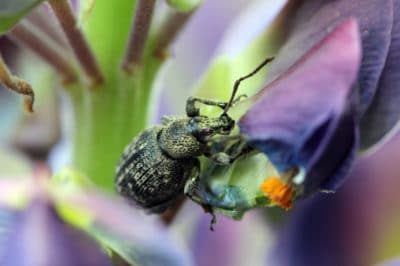Identifying Plum Curculio
The plum curculio beetle is 1/8 to ¼ inch (4 to 6mm) in length with a mixture of brown, orange, grey, and black colors on its back. The beetle has a long, downward-bending snout.
Adults emerge from debris on the ground and infest the tree in spring at about bloom time. The adults begin eating flowers, flower buds, and immature fruit and soon mate. Females lay eggs inside the skin of fruit in a small slit shaped like an indentation made by a fingernail.
Five days later, the eggs hatch out into tiny greyish-white worms in the fruit, and infested small fruits often fall off of the tree. The worms eat away at the fruit until they reach the center, then they return to the surface and go back into the soil to develop into an adult.
Signs of Plum Curculio
- Fingernail-shaped injury to the surface of fruit,
- Early fruit drop,
- Larvae living inside fallen plums,
- Presence of adult beetles on ground or tree,
- Small, brown marks on mature fruit where adults have eaten.
In warmer areas, plum curculio beetles can reproduce twice a year, infecting the tree in both spring and fall. In colder areas, trees are usually only affected once during fruit development.
Controlling Plum Curculio
The best time to spray for control of this pest in in the spring when the adult beetles come out of the ground. Spraying twice, ten days apart may be necessary for effective control. Always read and carefully follow the instructions on the package when applying an insecticide.
The only effective organic control for plum curculio is physically removing the beetles from the tree and the ground. This is not as hard as it may sound. The plum curculio is slow moving and easy to catch, especially early in the morning.
As soon as you see the beetles appear in spring, place a tarp under the tree and have a large bucket of soapy water nearby. Gently tap the branches of the tree with a broomstick, dislodging the beetles from the branches and collecting them on the tarp. Dump the beetles from the tarp into the soapy water to kill them.
Also, pick up all fallen fruit as soon as you see it. Dispose of the fruit in tightly sealed bags off site or burn it, if possible.
